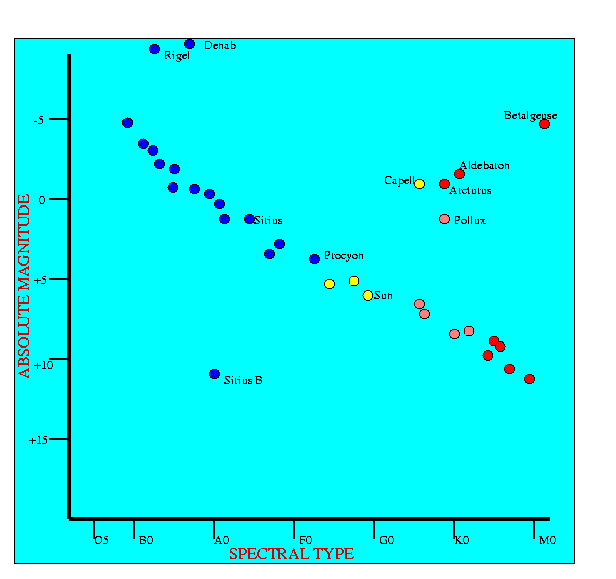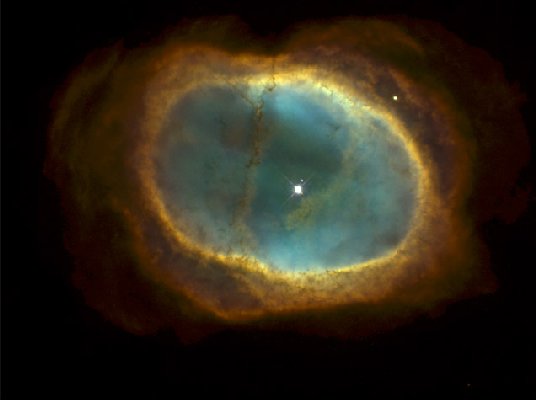Stars and Stellar Evolution: Lecture 14
Steller Maturity
A main sequence star is one burning hydrogen in its core.
A main sequence is very stable. Of course eventually the hydrogen in
the core will be used up and the star will have a core almost entirely
composed of helium. At this point the core will contract and the
hydrogen rich areas outside the core will also contract- this shell
will next ignite and the star will become shell hydrogen
burning. Such a star works differently from a core hydrogen burning
star and is called a red giant
Red Giants
As shell hydrogen takes over the star becomes rather
schizophrenic. Although the core is collapseing the outer reaches
above the burning shells expand and the whole star spreads out. For
our sun the surface of the star will expand until it reaches the orbit
of the earth. (at present the suns diameter is about 1/100 A.U.) The
outer reaches of the red giant are quite cool - it is red in
colour. However because of its huge surface area ( about 10,000 that
of the sun ) it is very luminous. Red giants are hence found in the
top right side of the HR diagram. Examples of red giants visable late
at night are Pollux (in Gemini) and Aldebaron (in taurus)
Evolutionary tracks
A star such as ours will head upwards and rightwards in the HR diagram
as it becomes a red giant. At this moment it will be shell hydrogen
burning. However temperatures/densities in the core will rise and
eventually core helium burning will take place. For small stars this
can be explosive and the onset is a helium flash . At this point the
evolutionary track takes a sharp turn and moves horizontally towards
the left (becoming much hotter). Eventually the core helium burning
will run out and the star will start shell helium burning and the star
will ascend upwards and rightwards again to become a red supergiant.

|
| HR diagram
|
| Evolutionary track of our Sun
|
|
Red Supergiants
Red supergiants are shell helium burning. They are truly huge. An
example of a red supergiant is
betelgeuse
which has a size about the
orbit of jupiter. In general a star such as betalguese is rather
unstable - its apparant magnitude varies between 0.4 and 1.2. In
general after leaving the main sequence stars become much less
reliable and stable objects.
In general large stars have a fairly complicated evolutionary track in
the supergiant area.
Death of Stars
We must determine what happens to stars after helium burning ceases.
This
depends
critically upon the size of the original star.
Small Stars M < 4.0 Ms
onsider such a star when it reaches Red supergiant status. It is burning
He to
carbon and Oxygen and has a large exterior far from the core. Whilst
burning it
is probably suffering serious mass-loss The far away gases can
be lost
in jets and can drift away from the star. In a small star these blown
away gasescan form a
planetary nebulae (a BAD name - nothing to do with planets!)
As helium runs out, because of the small size, pressures never get high
enough
to "burn" carbon and oxygen. Such stars then become White Dwarves
(see
pics.
and
another ).
A
white dwarf is the left over Carbon/Oxygen core at the centre of a
planerary
nebula. The outside material has blown off exposing the very-hot
carbon/oxygen
core. The core then basically just cools down over time. Such an object
lies tothe bottom left of a HR diagram since it is very hot but not very
bright. Left
over will be a "lump" of carbon/Oxygen. As it cools it will move
downwards to
the right in the HR diagram- eventually becoming a
black dwarf .
Sirius B is a good example of a white dwarf - it is
0.98
the mass of the sun but very dim.
The white dwarf is not as heavy as the original star because of the
amount of material ejected. For example a star of mass 3.0 Ms will
leave a
white dwarf of 1.2 Ms behind ejecting 1.8 Ms
in the planetary nebula.
A star
of mass 1.5 Ms will leave a white dwarf of 0.8 M_s and a star of 0.8
Ms will
leave a white dwarf of 0.6 Ms.
A white dwarf is extremely dense. The
sun will
leave behind a white dwarf about the size of the earth. This is a
density of
around 109 kg/m3 (the earth is 5000).
We have images of a variety of planetary nebula (look for white
dwarf in most )
- The Eskimo Nebula ,
the Southern ring nebula ,
NGC 5882 ,
NGC 5315 ,
NGC 6369
-
NGC 6537 ,
The cats eye nebula ,
Ring Nebula, M57 , NGC6720 ,
a nebula,
M2-9 ,
The Hourglass nebula ,
© Dave Dunbar 2019






